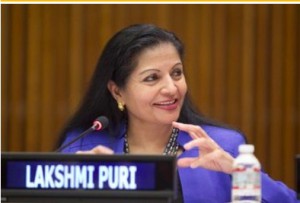. . WOMEN’S EQUALITY . .
An article by Tharanga Yakupitiyage, Inter Press Service (reprinted by permission)
Improving access to public spaces, and making them safe for women and girls, increases equity, combats discrimination and promotes inclusion, said Secretary-General Ban Ki-moon during a High-Level Discussion on “Public Spaces for All.”

The meeting coincided with World Habitat Day, which is observed annually on the first Monday of October.
It brought together top UN officials, private sector representatives, academics, and civil society members to discuss the state of the world’s towns and cities, the right to adequate shelter, and the importance of public spaces.
In Ban’s address, he remarked: “High-quality public spaces encourage people to communicate and collaborate with each other, and to participate in public life.”
“Public spaces can also provide basic services, enhance connectivity, spawn economic activity and raise property values while generating municipal revenue,” he continued.
The Executive Director of the UN Human Settlements Programme (UN-Habitat) Joan Clos echoed the UN Chief’s comments.
“These spaces shape the cultural identity of an area, are part of its unique character and provide a sense of place for local communities,” Clos stated.
Clos also warned that when public spaces are inadequate, poorly designed or privatized, a polarized city with high social tensions, crime and violence will result.
Deputy Executive Director of UN Women Lakshmi Puri particularly pointed to violence against women and girls in public spaces as a major challenge.
“If violence in the private domain is now widely recognized as a human rights violation, violence against women and girls, especially sexual harassment and other forms of sexual violence, in public spaces remains a largely neglected issue, with few laws or policies in place to prevent and address it,” Puri said.
(Article continued in right column)
Protecting women and girls against violence, Is progress being made?
(Article continued from left column)
UN Women has found that women in urban areas are twice as likely as men to experience violence, especially in developing countries. Moreover, 25-100 percent of women and girls around the world have experienced some form of sexual violence in public spaces in their lifetime.
Similarly, according to Gallup data from surveys in 143 countries in 2011, men are more likely than women to say they feel safe walking alone at night in their communities.
In Australia, research conducted by the Australia Institute in 2015 found that 87% of women were verbally or physically attacked while walking down the street.
In Ecuador, a study by UN Women in 2011 found that 68% of women had experience some form of sexual harassment and sexual violence in public spaces.
Puri noted how such violence limits women and girls’ movement, participation in education, access to essential services, and negatively impacts their health and well-being.
She highlighted the role of public spaces in promoting and achieving gender equality.
“Urban spaces are the most important theaters for the working out of the gender equality and women’s empowerment project,” Puri remarked.
Ban also noted the importance of deliberate and careful collaboration with local authorities, residents, and other actors to create successful public spaces.
World leaders are set to meet and define a new housing and urban agenda under the post-2015 development framework at Third UN Conference on Housing and Sustainable Urban Development, or Habitat III.
The conference will address the challenges of urbanization and opportunities it offers to implement the sustainable development goals (SDGs) and its targets.
One such target is 11.7 which aims to provide universal access to safe, inclusive and accessible, green and public spaces, particularly for women and children, older persons and persons with disabilities.
However, Puri noted that no target exists to measure safety in public spaces for women and girls in the SDGs.
(Thank you to Janet Hudgins, the CPNN reporter for this article.)